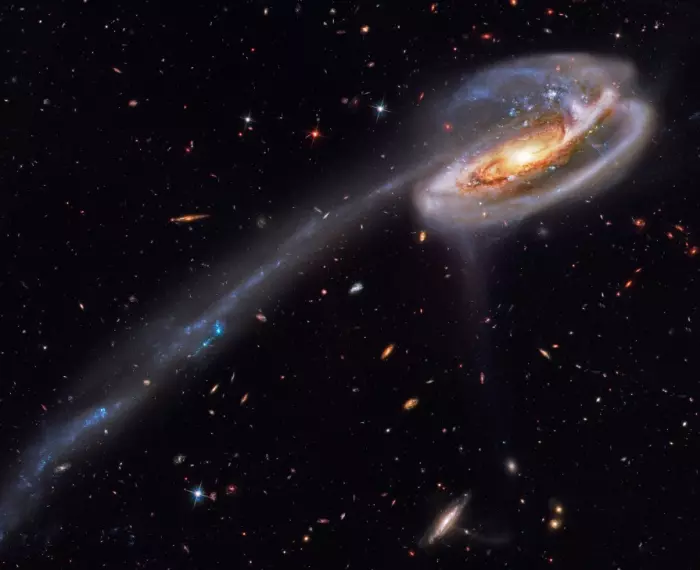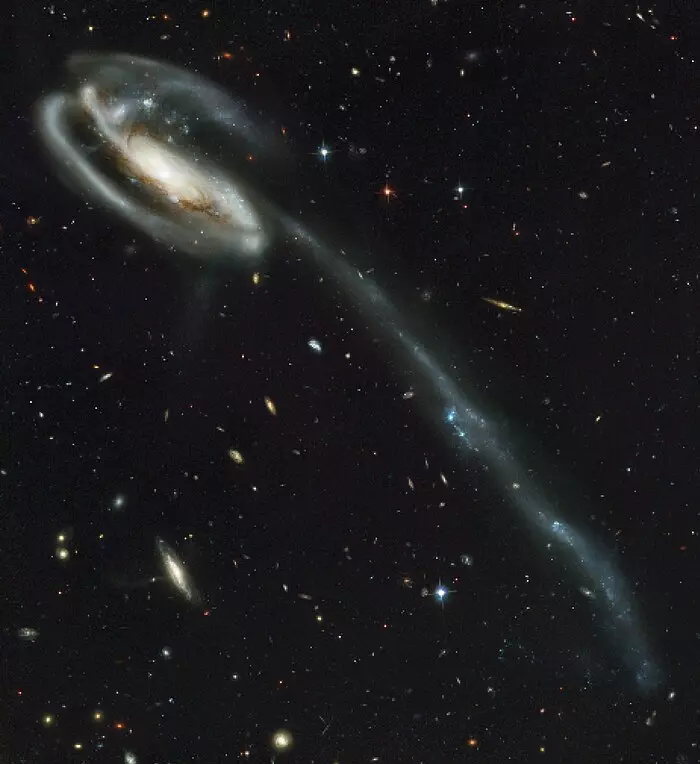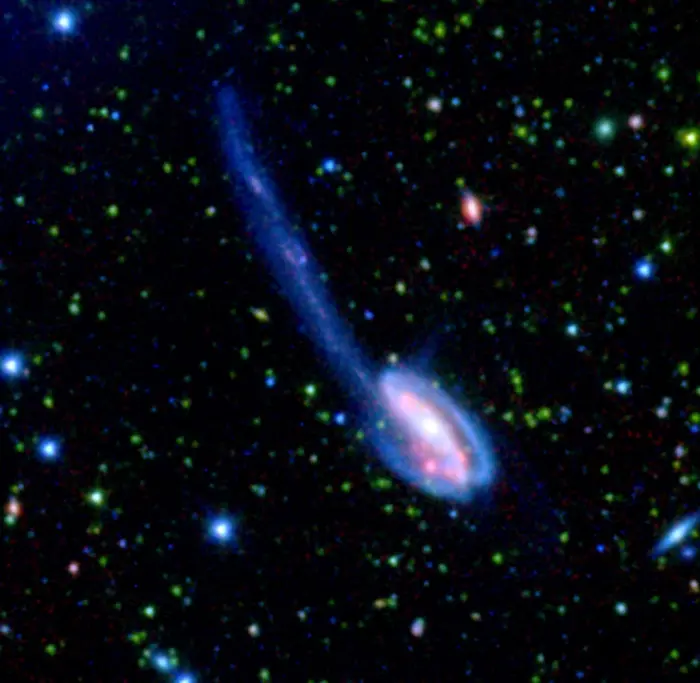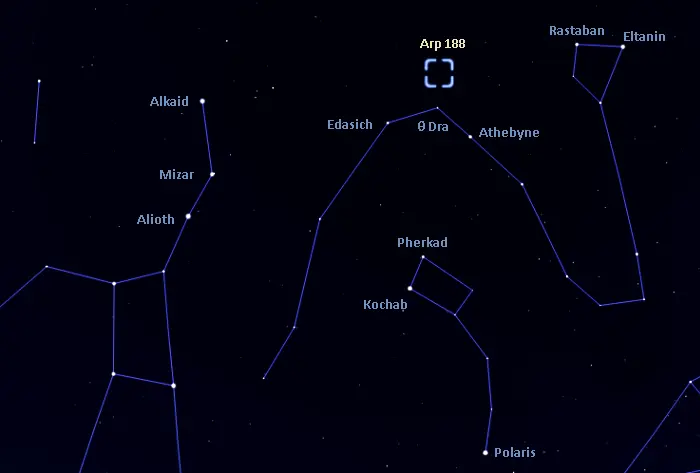The Tadpole Galaxy is a peculiar disrupted barred spiral galaxy located approximately 420 million light-years away in the constellation Draco. It has a disrupted shape with a trail of stars that stretches about 280,000 light-years from the galaxy. With an apparent magnitude of 14.4 and an apparent size of 3.6 by 0.8 arcminutes, the Tadpole can be spotted in 8- to 10-inch telescopes in good conditions.
The Tadpole Galaxy is catalogued as Arp 188 in Halton Arp’s Atlas of Peculiar Galaxies and UGC 10214 in the Uppsala General Catalogue of Galaxies.
The Tadpole Galaxy is the largest known disrupted galaxy of its kind. The tadpoles are a class of galaxies known for their bright heads and long tails. The knot-and-tail shapes indicate that the galaxies are going through galactic mergers.

Tadpole Galaxy (Arp 188), image credit: Hubble Legacy Archive, ESA, NASA; Processing – Bill Snyder (Heavens Mirror Observatory)
These galaxies are common in the distant universe, which indicates that many galaxies pass through a similar phase as they evolve. Hubble’s Ultra-Deep Field observations of the early universe have revealed that about 10% of all galaxies have these elongated shapes. However, these galaxies are rare in the local universe, which is why the celestial Tadpole is a frequent target of study.
The galaxy’s tidal tail stretches about 280,000 light-years across. The streamer of stars was produced in a collision with a smaller galaxy about 100 million years ago. The merger triggered star formation in the Tadpole Galaxy. The small interloper is a compact galaxy that appears in the upper left corner of the Hubble image of the Tadpole. It is visible in the Tadpole’s disk.
The smaller galaxy has likely passed through the larger one and will eventually leave. The compact intruder is believed to have crossed in front of the larger Tadpole and was slung behind the larger galaxy by mutual gravitational interaction. The strong gravitational forces of the close encounter have produced the long tail of debris, stars and gas that gives the larger galaxy its distorted shape and unusual appearance. The smaller galaxy is estimated to lie about 300,000 light-years behind the Tadpole. It is visible through the Tadpole’s spiral arms.
The Tadpole’s tail contains two prominent clumps of bright blue star clusters that are divided by a fainter section. The clumps of stars will likely evolve into dwarf galaxies that orbit in the halo of the larger Tadpole. As the two smaller satellites form, the Tadpole will lose its tail.
The Tadpole Galaxy is dotted with young blue star clusters, some of which contain as many as a million stars. The young blue stars and clusters appear in the galaxy’s spiral arms and in the long tidal tail.
The stars appear blue because they are hot and massive. They are 10 times hotter and about a million times brighter than the Sun. As they age and exhaust their supply of fuel, they will become redder. The young open clusters will become globular clusters similar to those observed in the halo of the Milky Way and other galaxies.
Facts
The Tadpole Galaxy has hosted two observed supernovae. The first, SN 2007cu, was detected on 27 June 2007. It had a visual magnitude of 18.9. The second supernova, SN 2008dq, was observed on 25 June, 2008. It had an apparent magnitude of 18.3.
An image of the Tadpole Galaxy captured with the Hubble Space Telescope’s (HST) Advanced Camera for Surveys (ACS) in April 2002 revealed about 6,000 background galaxies stretching across an area billions of light-years across. This was twice the number of galaxies discovered in the Hubble Deep Field image taken by the Wide Field and Planetary Camera 2 in 1995. The sharpness of the image allows astronomers to identify distant merging galaxies and other different types of galaxies located at exceptional distances. The galaxies in the ACS image have ages going back almost to the beginning of the universe and showcase its evolution over the past 13 billion years.

This picture of the galaxy UGC 10214 was was taken by the Advanced Camera for Surveys (ACS), which was installed aboard the Hubble Space Telescope (HST) in March 2002 during HST Servicing Mission 3B (STS-109 mission). Dubbed the “Tadpole,” this spiral galaxy is unlike the textbook images of stately galaxies. Its distorted shape was caused by a small interloper, a very blue, compact galaxy visible in the upper left corner of the more massive Tadpole. Image credit: NASA, H. Ford (JHU), G. Illingworth (USCS/LO), M. Clampin (STScI), G. Hartig (STScI), the ACS Science Team, and ESA
An image of the Tadpole taken by the Spitzer Wide-area Infrared Extragalactic (SWIRE) Legacy project in 2005 helped astronomers study the galaxies of the early universe. Galactic mergers like these are believed to have been common when the universe was much younger, and the detailed infrared image of the Tadpole has provided new insights into the “faint red-orange specks” of the early universe. The fields imaged by SWIRE were selected because they are relatively free of the obscuring dust, gas, and stars in the Milky Way.

This spectacular infrared image of the “Tadpole” galaxy, taken by the Spitzer Wide-area Infrared Extragalactic (SWIRE) Legacy project, encapsulates one of the primary objectives of the Spitzer mission: to connect the evolution of galaxies from the distant, or early, universe to the nearby, or present day, universe. Image credit: NASA/JPL-Caltech
Location
The Tadpole Galaxy lies in the region between the Big Dipper’s handle and the head of Draco. It appears along the imaginary line extended from Alkaid, the star at the end of the Dipper’s handle, and Eltanin, the brightest star in Draco. It can be found in the region where the Dragon curves around the bowl of the Little Dipper, near the faint star Theta Draconis. The brighter Edasich and Athebyne can be found using Polaris, Kochab and Pherkad, the brightest stars of the Little Dipper. Kochab and Pherkad point toward Athebyne, and Polaris and Pherkad, toward Edasich.

The location of the Tadpole Galaxy, image: Stellarium
The best time of the year to observe the Tadpole Galaxy and other deep sky objects in Draco is during the month of July, when the constellation is prominent in the northern evening sky. Observers in the northern hemisphere can see Draco throughout the year due to its proximity to the north celestial pole. The entire constellation is visible from locations north of the latitude 15° S.
At declination +55° 25′ 32″, the Tadpole Galaxy never rises for observers south of the latitude 34° S.
Tadpole Galaxy – Arp 188
| Constellation | Draco |
| Right ascension | 16h 06m 03.9s |
| Declination | +55° 25′ 32″ |
| Type | SB(s)c pec |
| Apparent magnitude | 14.4 |
| Apparent size | 3′.6 × 0′.8 |
| Distance | 400 million light-years |
| Redshift | 9,401 ± 15 km/s |
| Names and designations | Tadpole Galaxy, Arp 188, UGC 10214, PGC 57129, 2MASX J16060394+5525313, MCG+09-26-056, VV 29, SDSS J160603.92+552531.8 |